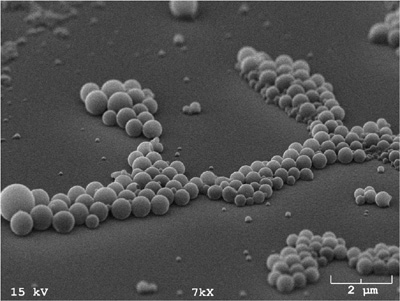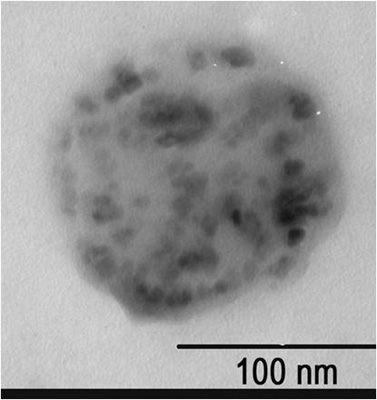

Poly (lactic-co-glycolic acid) (PLGA) degrades in water due to hydrolysis of ester bonds. In plain English, that means if you put PLGA in water, over time it will "disappear". PLGA is already being used for degradable sutures; for example if you split your head open because you were standing on a chair and fell into a table (as I did when I was 5 years old, my mom was NOT happy), then if you have PLGA stiches put in, this means you don't have to go back to the doctor's office to get them removed. PLGA is also being used for things like agriculture; anytime you see the words "time-release" this could be PLGA (however, it might not be either, there is a number of other competing technologies).
How fast PLGA degrades depends upon many things, one thing being size. If you have a particle that is on the order of ~250 nm; it can degrade over a period of many days (going on weeks actually). PLGA particles of this size have been used previously; the unique aspect of our work is that we are incorporating smaller nanoparticles in these ~250 nm particles. In one project, we are encapsulating superparamagnetic nanoparticles (SPIONs) that will allow us to use a magnet to draw the nanoparticles to the inner ear. This particular nanoparticle will also contain a drug(s) that will help either restore hearing or prevent loss of hearing after a very loud noise (e.g. for military applications). In another application, we are encapsulating nanoparticles to help speed bone growth in order to reduce the healing time associated with dental implants. Below are two pictures, on the left is a scanning electron micrograph of the nanoparticles; while on the right is a transmission electron micrograph of a single nanoparticles; the dark dots are SPIONs that are inside the particle.
 |
 |
R.D. Kopke, R.A. Wassel, F. Mondalek, B.P. Grady, K. Chen, J. Liu, D. Gibson, K.J. Dormer “Magnetic Nanoparticles: Inner Ear Targeted Molecule Delivery and Middle Ear Implant”, Audiology and Neurotology 11, 123 (2006).
R.A. Wassel, B.P. Grady, R.D. Kopke, K.J. Dormer, “Dispersion of super paramagnetic iron oxide nanoparticles in poly(D,L-lactide-co-glycolide) microparticles” Colloids and Surfaces A: Physicochemical and Engineering Aspects, 292, 125 (2007).
F.G. Mondalek, B.J. Lawrence, B.P. Kropp, B.P. Grady, K.M. Fung, S.V. Madihally, H.K. Lin, The Incorporation of Poly(lactic-co-glycolic) Acid Nanoparticles into Porcine Small Intestinal Submucosa Biomaterials, Biomaterials, 29, 1159 (2008).
Y. Wang, X. Gao, S. Kuriyavar, D. Bourne, B.P. Grady, K. Chen, K. Dormer, R.D. Kopke, Incorporation, release and effectiveness of dexamethasone in poly(lactic-co-glycolic acid) nanoparticles for inner ear drug delivery, Journal of Nanotechnology in Engineering and Medicine, 2, Art 011013 (2011).
K. Bootdee, M. Nithitanakul, B.P. Grady, “Synthesis and Encapsulation of Magnetite Nanoparticles in PLGA: Effect of Amount of PLGA on Characteristics of Encapsulated Nanoparticles”, Polymer Bulletin, 69, 195 (2012).
X.P. Du, K.J. Chen, S. Kuriyavar, R.D. Kopke, B.P. Grady, D.H. Bourne, W. Li, K.J. Dormer, “Magnetic Targeted Delivery of Dexamethasone Acetate Across the Round Window Membrane in Guinea Pigs”, Otology and Neurotology, 34, 42 (2013).